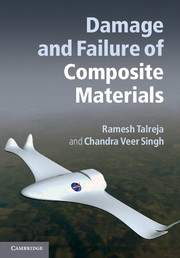Book contents
- Frontmatter
- Contents
- Preface
- 1 Durability assessment of composite structures
- 2 Review of mechanics of composite materials
- 3 Damage in composite materials
- 4 Micro-damage mechanics
- 5 Macro-damage mechanics
- 6 Damage progression
- 7 Damage mechanisms and fatigue-life diagrams
- 8 Future directions
- Author index
- Subject index
- References
8 - Future directions
Published online by Cambridge University Press: 05 July 2012
- Frontmatter
- Contents
- Preface
- 1 Durability assessment of composite structures
- 2 Review of mechanics of composite materials
- 3 Damage in composite materials
- 4 Micro-damage mechanics
- 5 Macro-damage mechanics
- 6 Damage progression
- 7 Damage mechanisms and fatigue-life diagrams
- 8 Future directions
- Author index
- Subject index
- References
Summary
In Chapter 1 we discussed the durability assessment of composite structures, the overall goal for the subject of this book. As outlined there in Figure 1.1, the mechanisms of damage and their effects on deformational response constitute the main thrust of the field of damage mechanics, which is at the core of durability assessment. After discussing the physical nature of damage observed experimentally in Chapter 3, the next two chapters treated the two main approaches in damage mechanics – micro-damage mechanics (MIDM) and macro-damage mechanics (MADM), both aimed at predicting deformational response at fixed damage. Damage evolution was treated in Chapter 6, while Chapter 7 was devoted to fatigue, a subject that requires special attention due to the conceptual difficulties it poses.
In closing the book we wish in this chapter to review what has been achieved and what directions the field of damage and failure of composite materials should pursue to further advance toward durability assessment and beyond.
Computational structural analysis
Obviously, complex structural geometries require computational structural analysis. The analytical modeling of damage initiation and evolution, and its effects on deformational response of composite laminates, discussed in previous chapters, were developed for idealized simple cases. Direct application of these models is limited to structures with simple geometry and loading conditions. For complex geometries, such as an airplane wing or a wind turbine blade, usually subjected to multi-axial mechanical loads, and possibly combined with thermal and moisture environments as well as manufacturing-induced residual stresses, computational approaches are inevitable. In industry, one often uses commercial software, e.g., ANSYS, ABAQUS, and NASTRAN, and the obvious need is to integrate damage and failure analyses into these codes. Efforts have been made to attempt some simple test cases where FE analysis of composites is combined with damage using failure criteria [1]. A series of World Wide Failure Exercises (WWFE) [2–4] have been conducted to compare several composite failure models with experimental data and provide guidance for their usage in composite design.
- Type
- Chapter
- Information
- Damage and Failure of Composite Materials , pp. 276 - 300Publisher: Cambridge University PressPrint publication year: 2012



